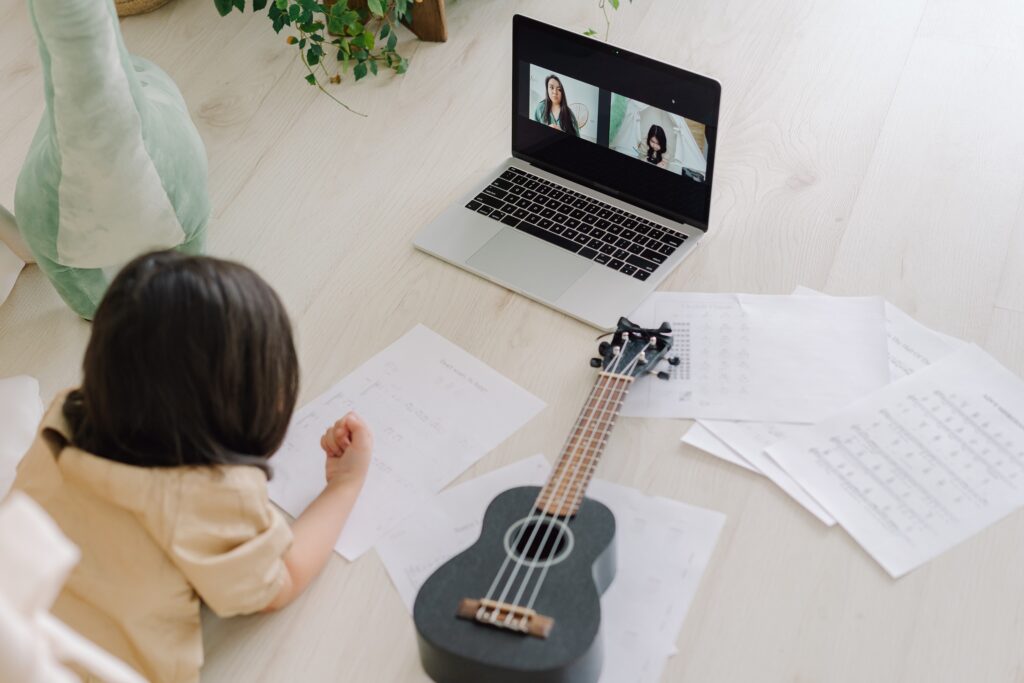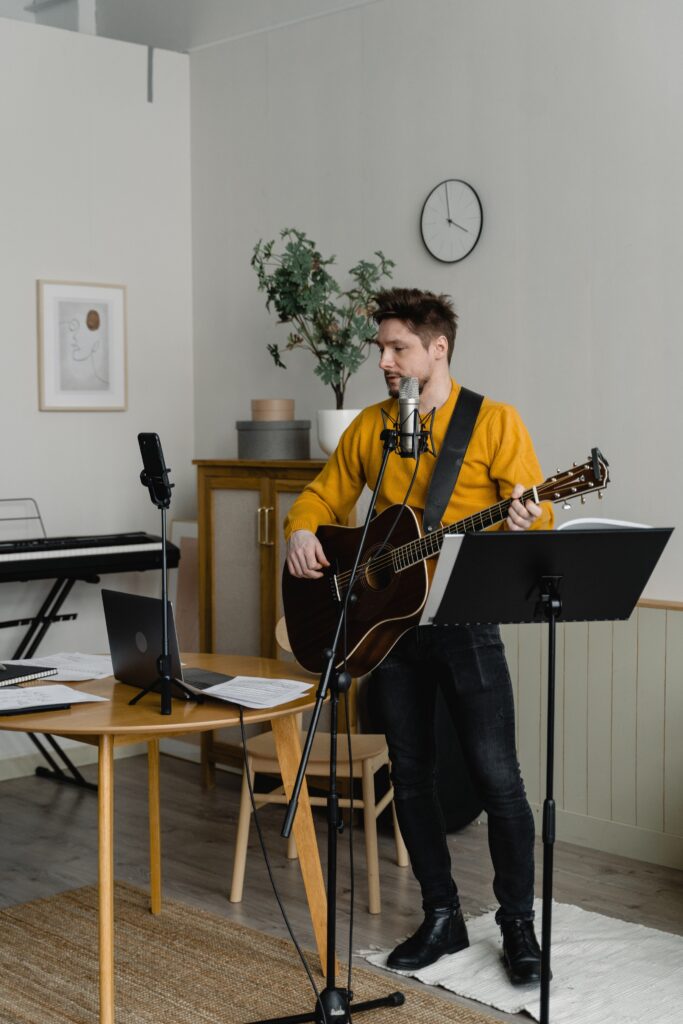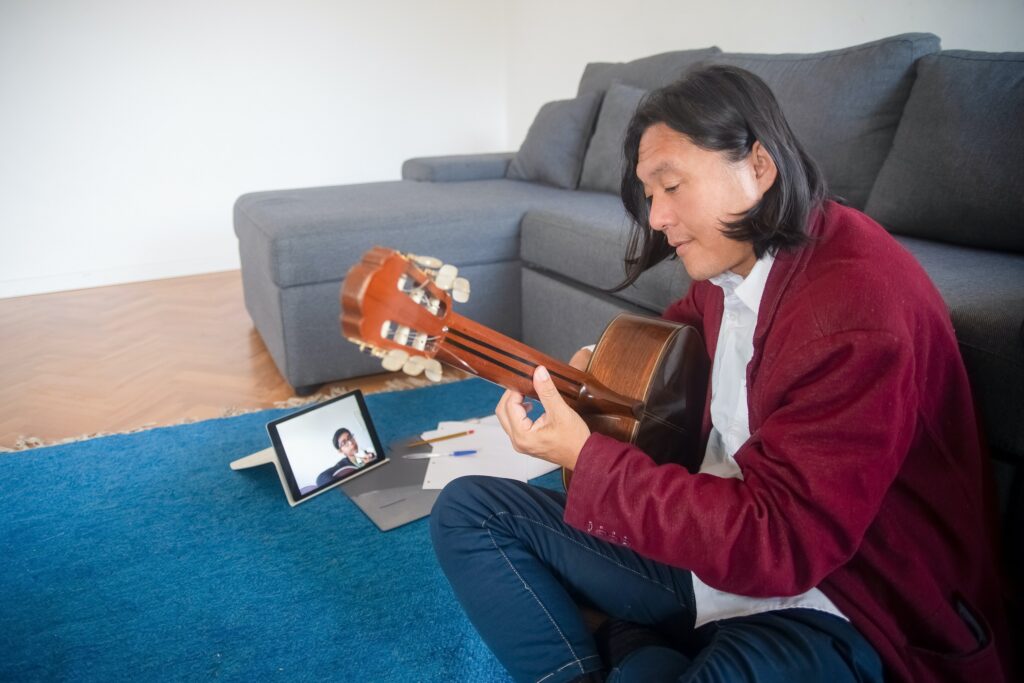Can music teachers work from home? This is a question that has become increasingly relevant in today’s technologically advanced world.
Music teaching, traditionally conducted in person, has seen a remarkable shift towards remote learning due to the advancements in communication technology. In this article, we will explore the possibilities and advantages of teaching music from the comfort of one’s home.
And of course, I will give an answer to the question “can music teachers work from home?”. Spoiler: They can.
Before delving into the intricacies of remote music teaching, it is essential to establish a clear understanding of what music teaching entails. Music teaching involves imparting knowledge and skills related to various aspects of music, such as playing an instrument, vocal techniques, music theory, composition, and performance.
It encompasses guiding students on their musical journey, nurturing their talents, and helping them develop a deep appreciation for music. In traditional settings, music teachers would typically conduct lessons face-to-face with their students in classrooms or private studios.
These interactions allowed for immediate feedback, personal guidance, and the opportunity for hands-on demonstrations. However, with the advent of modern technology and its integration into education systems worldwide, remote music learning has emerged as a viable alternative.
Technological Advancements Make Teaching Music From Home Possible
The proliferation of high-speed internet connections and advancements in video conferencing software has revolutionized how education is delivered. The field of music education is no exception; it has witnessed an increasing number of music teachers embracing online platforms to connect with students.
Remote learning offers numerous benefits that have encouraged this shift. With just a stable internet connection and compatible devices like computers or tablets equipped with audio interfaces and cameras—accessibility becomes virtually limitless.
Students who may have previously faced geographical limitations or lacked access to quality local instructors can now engage with top-notch educators from across the globe at their convenience. Moreover, remote music teaching allows for flexible scheduling, eliminating the need for time-consuming commutes to physical locations.
Teachers and students can coordinate lesson times that suit their individual routines, leading to increased convenience and efficiency. This flexibility also extends to music teachers who can teach part-time or expand their student base without being confined by geographical boundaries.
The advent of technology has opened up new possibilities for music teachers to embrace remote teaching methods. The next sections will explore the advantages of teaching music from home in more detail, and discuss the necessary equipment and setup required for seamless remote lessons.
I will also delve into online platforms that facilitate music education effectively, address challenges faced during remote teaching, and provide insights on adapting music teaching techniques to the online environment.

Benefits of Teaching Music from Home
If you wonder if you can work from home as a music teacher, the answer is yes. But not only yes – it is also a very beneficial way to work with music teaching.
Flexibility in Scheduling Lessons
When it comes to teaching music from the comfort of your own home, one of the most enticing advantages is the unparalleled flexibility in scheduling lessons. Gone are the days of being tied to a rigid timetable or conflicting commitments. As a music teacher, you have the freedom to structure your day according to your preferences and availability.
Whether you’re an early bird or a night owl, you can accommodate students during times that work best for both parties. Furthermore, this flexibility extends beyond just daily scheduling.
With remote teaching, you have the ability to adjust lesson durations based on individual student needs. Some students may require longer sessions for complex concepts or composition projects, while others may benefit from shorter bursts focusing on specific techniques.
Without the constraints of physical travel and classroom changes, you have full control over optimizing lesson lengths as per each student’s requirements. In essence, by embracing remote teaching, music educators can achieve a harmonious work-life balance that enhances their productivity and allows them to cater to their students’ needs effectively.
Elimination of Commuting Time and Expenses
Avoiding lengthy commutes is undoubtedly one of the most liberating aspects of teaching music from home. Bid farewell to traffic jams and rush hour stress! Instead, imagine strolling into your cozy home studio with no wasted time spent navigating congested roads or crowded public transportation.
Not only does remote teaching save precious minutes or even hours each day that would otherwise be wasted in transit, but it also eradicates associated expenses such as fuel costs or public transport fares. Think about how much money could be saved annually by eliminating these expenditures. It’s crazy.
Besides financial savings, avoiding commuting also reduces our carbon footprint—a small contribution towards protecting the environment. So, embrace the opportunity to teach music from home and relish its comfort and convenience.
Working From Home Increases Accessibility to Students in Remote Areas
Traditional music education often faces limitations in terms of accessibility, especially for students residing in remote areas or those with limited mobility. However, remote teaching is a game-changer in this regard. By embracing technology, music teachers can now reach students who were previously unable to access quality music education due to geographical constraints.
Regardless of where they live, as long as there is an internet connection available, students can connect with highly skilled teachers from around the world. This newfound accessibility not only broadens educational opportunities but also fosters diversity within the musical community.
Students from different cultures and backgrounds can now learn from a wide range of educators, exposing them to varied pedagogical approaches and musical styles.
Ultimately, by teaching music remotely, you’re breaking down barriers and providing invaluable learning experiences to students who might otherwise have been denied those opportunities.

So, What Equipment Do You Need for Teaching Music From Home?
Teaching music from home requires the right equipment and the right setup. Of course, it depends on what your ambition is with teaching from home. But depending on how professional a setup you want, you do need some accessories to get going with working from home as a music teacher.
High-Quality Audio Equipment for Clear Sound Transmission
When it comes to teaching music online, having crystal clear audio is paramount. You want your students to hear every nuance, every subtle phrasing, and every delicate note.
To achieve this level of auditory excellence, investing in high-quality audio equipment is crucial. Consider purchasing a good microphone, such as a condenser or dynamic microphone, that can capture the richness of your instrument or voice.
Pair it with professional-grade headphones that offer accurate sound reproduction, ensuring you can hear your students’ performances with precision. Additionally, an audio interface will allow you to connect your microphone and headphones directly to your computer for optimal sound quality.
You can also invest in wall decorations that hinder background noise. Both your students and your family will benefit from that.
Video Setup for Visual Playing and Feedback
While sound is of utmost importance in music teaching, visuals play a significant role as well. Being able to provide visual demonstrations and feedback enhances the learning experience for your students. A reliable camera is an essential component of your setup.
Opt for a high-definition webcam or even consider using a DSLR camera if you want top-tier video quality. Tripods are also invaluable in keeping the camera steady during lessons and allowing you freedom of movement without compromising stability.
A ring light will make sure that you always shine when on camera. Or at least look like your normal self and everyone can clearly see you.
Use Multiple Angles for Better Visibility
To provide an immersive experience during remote music lessons, utilizing multiple camera angles can greatly enhance visibility for both you and your students.
By positioning additional cameras around your teaching area (whether it’s a studio or a dedicated space in your home), you can show different perspectives of yourself playing or demonstrate intricate fingerings on instruments like guitar or piano from various angles. As musicians often rely on visual cues during performances, good lighting becomes crucial when teaching online.
Consider investing in proper lighting equipment that illuminates not only yourself but also the area where sheet music or instruments are positioned. This way, your students can clearly see your facial expressions, hand movements, and any written material you share during the lesson.
Investing in reliable equipment demonstrates your commitment to delivering the best possible online music education experience. While it may require some financial investment upfront, the benefits of clear audio transmission, high-quality video demonstrations, and well-lit teaching environments will greatly contribute to the success of your remote music teaching endeavor.
How to Choose the Right Online Platforms for Teaching Music
So, you want to work from home as a music teacher. But where do you actually go? Choosing the right platforms to brand yourself as a remote music teacher can make or break your remote music teacher career.
The Best Online Conferencing Tools
When it comes to teaching music online, one cannot ignore the convenience and popularity of video conferencing tools. Zoom, Skype, and Google Meet have emerged as the front-runners in this ever-expanding landscape. Each platform offers unique features that cater to music teachers’ needs.
- Zoom has gained tremendous popularity due to its user-friendly interface and robust audio quality. It provides clear sound transmission, ensuring that students can hear every nuance of their instructor’s guidance or musical demonstrations.
- Additionally, Zoom allows screen sharing capabilities, which is invaluable for displaying sheet music or other visual aids during lessons.
- Skype, on the other hand, has been a long-standing player in the field of online communication.
- While it may not offer as many features as Zoom or Google Meet, Skype’s audio quality is impressive and reliable. It also supports screen sharing capabilities so that music teachers can share their digital resources effortlessly with their students.
- Google Meet is another widely used platform that offers excellent audio quality for remote music lessons.
- Moreover, it integrates seamlessly with other Google applications such as Google Drive and Google Calendar, enabling instructors to efficiently organize their lesson materials and schedules.
Dedicated Platforms for Remote Music Teachers
While popular video conferencing tools serve their purpose well enough for basic online lessons, dedicated music teaching platforms like Lessonface or TakeLessons provide an enhanced experience tailored specifically to meet the unique needs of music education.
Another popular platform for learning music and other skills is Skillshare.
One notable advantage of using specialized platforms is their focus on providing a comprehensive environment for learning music online. These platforms often include features such as built-in metronomes or tuners that can be accessed directly within the lesson interface.
Moreover, they may offer advanced recording options allowing students to record themselves playing musical pieces during practice sessions for self-assessment.
Additionally, specialized platforms often have a larger network of music teachers, enabling students to choose from a broader range of instructors with various specialties.
This diversity allows students to find the perfect match for their musical ambitions, whether they wish to learn classical piano or jazz saxophone.
While popular video conferencing tools like Zoom, Skype, and Google Meet offer adequate solutions for remote music teaching, dedicated music teaching platforms like Lessonface, Skillshare or TakeLessons provide additional benefits tailored specifically to the needs of music educators.
These platforms often include advanced features designed to enhance the online learning experience for both teachers and students.

How to Overcome the Challenges in Teaching Music From Home
It is certainly possible to teach music from home. But it does not come without any challenges, that is. But don’t worry – here you can learn how to combat the challenges of teaching music from home.
Maintaining Student Engagement and Focus Without Physical Presence
When it comes to teaching music remotely, one of the biggest challenges lies in maintaining student engagement and focus without the physical presence of a teacher.
In a traditional setting, a music teacher can use body language, eye contact, and proximity to captivate students’ attention. However, in an online environment, teachers must rely on other tactics.
Incorporating interactive activities during lessons is a fantastic way to keep students engaged. For example, instead of solely lecturing or demonstrating, teachers can assign exercises that require student participation.
This could include asking them to play along with backing tracks or challenging them with sight-reading exercises. By actively involving students in the learning process, their engagement levels are likely to soar.
Additionally, encouraging regular practice through effective communication is vital for remote music teaching success. Teachers can set clear expectations for practice time and communicate these guidelines directly with students and their parents.
Regular check-ins via email or video calls can also help track progress and provide valuable feedback. Nurturing this communication channel between the teacher and student outside lesson times, it helps maintain motivation and accountability.
Addressing Technical Issues During Online Lessons
While online music lessons offer convenience and flexibility, technical issues can sometimes disrupt the flow of teaching sessions. Addressing these issues promptly is crucial to ensure smooth online learning experiences for both teachers and students.
Troubleshooting common audio/video problems is essential to minimize disruptions during lessons. Teachers should guide students through checking their microphone settings or ensuring they have selected the correct input devices on their computers or smartphones.
Additionally, advising students on optimizing their internet connection by suggesting wired connections rather than relying solely on Wi-Fi can significantly improve audio/video stability. To further support connectivity issues that may arise beyond immediate troubleshooting capabilities during lessons, providing resources for students becomes paramount.
This can include creating tutorials or guides on resolving common connectivity issues or recommending online forums and communities where students can seek assistance. By equipping students with the tools to troubleshoot independently, teachers empower them to overcome technical obstacles and continue their musical development.
Maintaining student engagement and addressing technical issues are vital aspects of successful remote music teaching. By incorporating interactive activities during lessons and encouraging regular communication for practice accountability, teachers can keep students invested in their musical journey.
Additionally, effectively troubleshooting common audio/video problems and providing resources for connectivity issues ensures uninterrupted learning experiences. With these strategies in place, music teachers can confidently navigate the challenges of teaching from home and continue to inspire students through the power of music.
Adapting Your Music Teaching Techniques to the Online Environment
It is not a given that you can just adapt your offline music teaching skills to an online environment. There are a bunch of skills and “things” you need to learn to succeed with it.
Utilizing Screen Sharing for Sheet Music or Digital Resources
In the online teaching realm, one of the greatest advantages is the ability to share screens. This feature allows music teachers to present sheet music, digital resources, and even their own written notes directly to their students.
By using screen sharing, teachers can guide students through each note and highlight important sections in real time. They can annotate the music score together, making it easier for students to understand complex musical concepts and techniques.
Visual aids such as arrows or text boxes can be added to further emphasize key points. The convenience of screen sharing ensures that both teacher and student are on the same page (quite literally!), fostering a more efficient and interactive learning experience.
Incorporating Virtual Collaboration Tools for Ensemble Playing
This one is huge. One challenge faced by music teachers when transitioning to online teaching is replicating ensemble experiences. However, with modern virtual collaboration tools, this hurdle becomes surmountable.
These platforms allow multiple participants to play simultaneously from different locations in real time. Music teachers can now create virtual ensembles by combining individual recordings from their students into a cohesive performance.
Students can listen to each other’s parts while playing along in synchronization, gaining valuable experience in ensemble dynamics despite being physically apart. Collaborative platforms also enable live feedback during rehearsals, fostering a sense of camaraderie among musicians. Conclusion:
Teaching music from home has become an achievable reality thanks to technological advancements and innovative solutions specifically designed for online education. By adapting teaching techniques to the online environment, music teachers can take advantage of features like screen sharing to provide visual aids such as sheet music or digital resources in real time during lessons.
Additionally, virtual collaboration tools make it possible for students to engage in ensemble playing despite being physically separated. The availability of these tools enhances the overall learning experience, ensuring that students receive the same level of guidance and interaction as they would in a traditional in-person setting.
So, Can Music Teachers Work From Home? Yes, The Definetly Can
Whether you’re teaching piano, guitar, or singing lessons, don’t be discouraged by the physical distance between you and your students. Embrace the possibilities of online teaching and explore the vast array of resources at your disposal.
Because in this modern era, every music teacher can take their knowledge and bring it in front of an online audience. Teaching music from home is very much an option, yes.
With dedication and creativity, you can inspire and nurture musical talent from the comfort of your own home.
So, let the harmonies carry through cyberspace!
My name is Frederik
I am a passionate marketeer who loves the freedom that comes with working from home whenever I choose to do so.
I love getting nerdy with every single detail about making everything related to my home just a tiny bit better.
That is what motivates me to write about home stuff on this blog.
-
Frederik Fisker Waehrenshttps://myeasyhomelife.com/author/frederik-fisker-waehrens/
-
Frederik Fisker Waehrenshttps://myeasyhomelife.com/author/frederik-fisker-waehrens/
-
Frederik Fisker Waehrenshttps://myeasyhomelife.com/author/frederik-fisker-waehrens/
-
Frederik Fisker Waehrenshttps://myeasyhomelife.com/author/frederik-fisker-waehrens/


